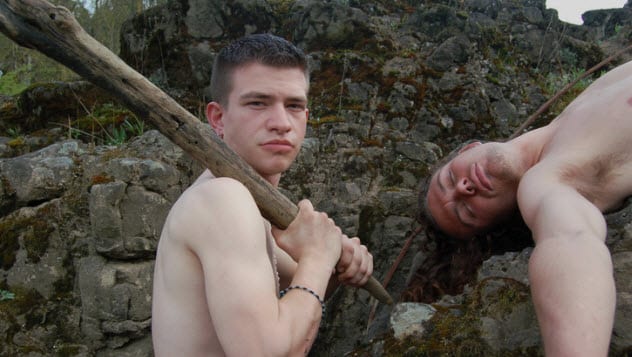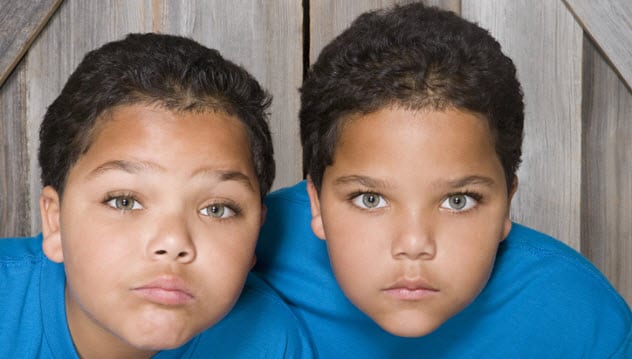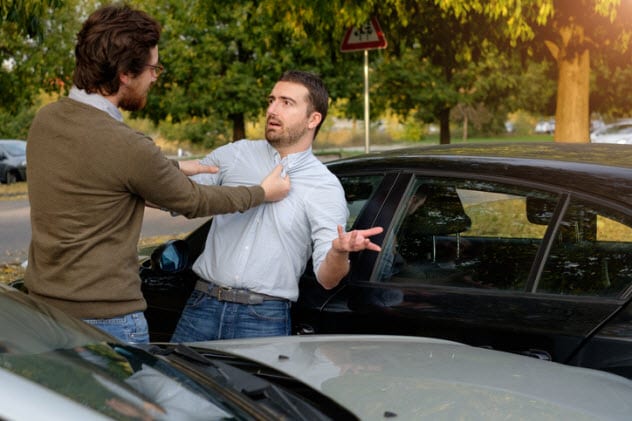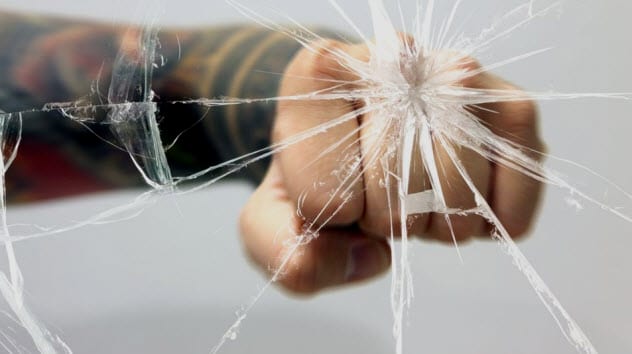 Mysteries
Mysteries  Mysteries
Mysteries  History
History 10 Surprising Stories About the Texas Rangers
 Humans
Humans 10 Philosophers Who Were Driven Mad by Their Own Theories
 Miscellaneous
Miscellaneous 10 Video-Game-Worthy Weapons and Armors from History
 Weird Stuff
Weird Stuff 10 Psychics Who Accurately Predicted Wartime Events
 The Arts
The Arts 10 Pieces of Art Inspired by a Broken Heart
 Health
Health 10 Science Fiction-Sounding New Medical Treatments
 History
History 10 Surprising Facts About the Father of Submarine Warfare
 Space
Space Ten Astonishing New Insights into Alien Worlds
 Weird Stuff
Weird Stuff 10 Bizarre Summer Solstice Rituals Still Practiced Today
 Mysteries
Mysteries Top 10 Haunting Facts About the Ghost Ship MV Alta
 History
History 10 Surprising Stories About the Texas Rangers
 Humans
Humans 10 Philosophers Who Were Driven Mad by Their Own Theories
Who's Behind Listverse?

Jamie Frater
Head Editor
Jamie founded Listverse due to an insatiable desire to share fascinating, obscure, and bizarre facts. He has been a guest speaker on numerous national radio and television stations and is a five time published author.
More About Us Miscellaneous
Miscellaneous 10 Video-Game-Worthy Weapons and Armors from History
 Weird Stuff
Weird Stuff 10 Psychics Who Accurately Predicted Wartime Events
 The Arts
The Arts 10 Pieces of Art Inspired by a Broken Heart
 Health
Health 10 Science Fiction-Sounding New Medical Treatments
 History
History 10 Surprising Facts About the Father of Submarine Warfare
 Space
Space Ten Astonishing New Insights into Alien Worlds
 Weird Stuff
Weird Stuff 10 Bizarre Summer Solstice Rituals Still Practiced Today
10 Unnerving Facts About Human Violence From Modern Science
What are the causes of violence? Why does it exist in the world?
Even today, many people believe that some individuals are just violent and there is no sense in trying to understand it or do anything about it. Others have sought deeper explanations to understand the underpinnings of violence.
Enlightenment liberalism has taught us that people are sensible, rational creatures who occasionally err on their noble paths and in their pursuit of a life worth living. Later, existentialism spelled out a philosophy of the individual in crisis, terrified of his own existence and responsibility. This paved the way for postmodernism, which saw the world with a new, profound skepticism.
Violence became the norm, at least for philosophers of the early to mid-20th century. Then the 1960s counterculture revolution happened, further solidifying the ideas of individualism, moral relativism, and a “do what you want” type of attitude.
Still, some individuals today search for an answer to the violence question in the very fabric of our DNA. Is violence in our biology? Here are 10 insane links between human biology and violence.
10 The First Violence

Violence has always been a part of humanity, which suggests evolutionary psychology. One glance at the prehistoric mass graves of old shows that warfare has been with us for a very long time. The world is filled with the skeletal remains of the victims of interpersonal violence.
The general idea from the world of evolutionary psychology is that violence is neither the norm nor the exception but rather latent in every individual. A combination of adaptations from evolutionary pressures has created a human being who is predisposed to becoming violent under specific sets of environmental stimuli.
We all have a certain level of supposed social status that our peers and we generally agree upon, even if it’s nonverbal. When this social hierarchy is challenged, we don’t resort to violence indiscriminately. Violence has always been evolutionarily costly in that things like discussion are much more appropriate routes as physical altercations can easily get you killed.
This suggests that there is an established hierarchy of negotiations, starting with nonverbal gestures, then discussion, then warnings, and finally violence. This model seems to be fairly accurate and describes what the earliest cases of violence were probably like.[1]
Except for a few serial killers, almost all people are only occasionally violent through evolutionary pressures when they need to be and feel as if their well-being, especially relating to their social status, is threatened.
9 Variability

Evolutionary psychology also proposes a certain amount of variability in the likelihood of a person engaging in violence. Much of it has to do with the individual’s biological underpinnings and how he responds to his situation and the changing circumstances surrounding him.
The general idea is that human beings become violent when the two most important parts of our biology are threatened—our own survival and our mating strategies which pass our genes to our offspring. As a result, there is a certain amount of variability in how much an individual feels that these two critical parts of their existence are threatened. The more they feel like they’re unlikely to survive or reproduce, the greater the likelihood that they will become violent.
According to the bulk of the work of evolutionary psychology, it seems that the answer to the question, “Are we violent?” is “Well, sometimes.” There has been a certain adaptability of organisms to function in new and changing environments, which is the cornerstone of biology as seen through the lens of evolution.[2]
8 Reward

A glimpse at the stories and histories of most serial killers, the most extreme among us, will show that pleasure and violence are very much intertwined. This is largely because violence and power are connected and create a rush in our psyche that makes us feel alive. This is true of both humans and animals.
Some cutting-edge research is starting to show the exact flood of reward chemicals which takes place when one engages in violence, fantasizes about it, or witnesses it. This was the case with brutal sporting events and ancient Roman gladiators.
However, the facts might be even more alarming and startling. There is a good possibility that antisocial or even psychopathic traits, when pondered or acted upon, are hardwired to be rewarded by chemicals in the brain which make us feel good—like a quick surge of dopamine.[3]
Variability still exists, and there are more socially acceptable versions of the same reward in the brain. Even so, the brain rewards violence and violent tendencies, and we’ve figured out at least some of the chemical mechanism with which it does so.
7 Violence and Sex

The reward overdose in the brain that comes from violence is partially intertwined with sex. Although this in no way excuses or condones sexual violence, this research presents the possibility of understanding the causal connections of violence with other aspects of our lives in an attempt to address them. While modern biology tells us that the brain rewards violent behavior at times, evolutionary psychology tells us that this came about for a reason: strategy.
Organisms have two primary goals, one of which is mating. When that goal is threatened—even perceptively—organisms become increasingly desperate and much more likely to lash out in violence. A successful expulsion of violence could reward the brain and reinforce this behavior.[4]
It seems that the sex and violence link has presented itself in some very ugly ways in our modern society, namely domestic violence, rape, and other horrors of the human reality. But these explanations aren’t without promise. They seek to account for the constancy with which sexual violence finds itself on our world stage and perhaps address it someday.
For now, however, it seems that one of the main causes of sexual violence is built right into our genes—the pervasive nature of jealousy and our tendency to lash out violently when we feel that our reproductive prowess is under threat. Jealousy is the ugly face of those evolutionary links that were forged a long time ago.
6 Nature

For the longest time, social scientists and psychologists perceived violence in one of two ways. The cultural view of individual violence suggested that it was an outgrowth of living in a modern society. The opposing view said that violence is 100 percent hardwired in the genes. Under that theory, an individual predisposed to violence was guaranteed to lash out.
Thankfully, we’ve narrowed it down to a more moderate, balanced view. The evidence is clear and abundant that violence isn’t inherent in specific humans by nature, but there is a predisposition toward violence that we all carry. This can be manifested by external forces putting pressure on this predisposition.
Surprisingly, the amount of nature and nurture involved in the propensity toward violence latent in the individual is about 50–50. So, half of it is genes and the other half is environment. A massive amount of work has gone into understanding just how much of a role environment plays in one’s propensity toward becoming violent.[5]
Nevertheless, genes or some sense of “human nature” isn’t a sufficient explanation for the cause of interpersonal violence. We know beyond a doubt that nurture and environment play a role, too.
5 Heritability

Antisocial behavior and violent, aggressive, or otherwise quarrelsome tendencies have a heritability of about 50 percent. This means that half of your darker, violent side was passed down to you through your parents. We know this through a series of studies on identical twins. They share 100 percent of the same genes and usually the same environment, except in cases of adoption.
This is how we compare and contrast genetics versus outcome and see how much of a role the environment plays from there. Slowly, environmental factors begin to whittle away at what initially looked like a genetic cause. Fraternal twins also share 50 percent of their DNA, making them a good contrast against the general population and identical twins.[6]
Scientists are then able to compare the different groups—those with identical genes, those with half of the same genes, and the general human population. Identical twins, who share 100 percent of the same genes, could end up having very different outcomes when it comes to their violent tendencies in life if they are raised in separate households, as is the case when one twin gets adopted.
4 Accidents

While evolutionary theory and the related science may be painting a picture in your head of a particularly violent species, this view is rather inaccurate. Something about the propensity of humans to engage in violence is a bit accidental in nature.
The links of accidental things, where genes serve to predispose an individual to several different types of behaviors, blend together, and sometimes, violence is a by-product. It is an outgrowth of those genes which were selected and passed on due to other reasons.
In short, the human race isn’t an overtly violent species contrary to how this may be interpreted. We just have some kinks in the wiring that sometimes go off in unfortunate directions. Many of these kinks are the occasional expressions of genes which are wholly unrelated to violence. In some cases, genes which predispose one to perfectly harmless behaviors may also induce one to engage in very harmful behaviors.[7]
3 War

As if interpersonal violence weren’t enough on the individual level, we still need to account for violence on the societal level (aka war). Most people tend to think of evolution as “survival of the fittest” and living long enough to pass on your genes (natural selection).
What many often miss is the sexual selection element of biology. Those behaviors may decrease the likelihood of survival but increase the chances of mating and successfully passing on your genes to offspring.
One of the main factors responsible for successful mating in human societies is social status. Wealthy, powerful, beautiful, and otherwise socially desirable people have greater mating opportunities, or so the theory goes.
This explains a lot when it comes to questions like, “Why on Earth would someone go to war knowing they’ll likely die and never have a family?” The answer is simple: status. Honor, dignity, having a good name—all these things come into play when it comes to the ability to choose the best mates and ensure the best chances of survival of our offspring.
The link is the desire for status and prestige, which often drives the human propensity toward violence, especially in larger groups or whole societies. Some have theorized that war might just boil down to sex and social status, and there might be some merit to this idea.[8]
2 Testosterone

Although violence is not a wholly male trait, testosterone plays a large role in the history of violence. It even traces back to the primate world, where testosterone-filled male chimpanzees are horribly brutal to one another.
Males of all different species of primates tend to fight, bully, recruit groups or bands to carry out acts of violence, and have other generally savage tendencies. Notice the word “tendencies.” Testosterone alone does not produce violence. But it can cause individuals to seek social status and power, which is all too often reinforced by violence.
There are nonviolent traits which are also produced by testosterone, such as competitiveness, which isn’t inherently violent. Many supposedly brutal traits are outgrowths of nonviolent traits, like the desire for prestige or a certain standard of living. Testosterone and violence are linked but only indirectly.[9]
1 Genes

Scientists believe they have isolated a pair of “human warrior genes,” which may play a massive role in a person’s likelihood of committing violence. The genes also predispose one to poor choices, especially under the influence of alcohol. In fact, these genes may play some role in the use of alcohol.
Believe it or not, these genetic mutations are only found in men. They’re found in high concentrations in men who drink a lot and who commit criminal acts, especially under the influence of alcohol. The mutations seem to promote risky, daring behaviors.
MAOA and CDH13 are the genes in question. Even more striking, this cutting-edge Finnish research found that exposure to childhood abuse or neglect didn’t really increase the risk of violent behavior in the subjects in possession of these genes—but drug and alcohol use did.
Although prior abuse didn’t have much effect in the studies conducted, drug and alcohol use was a massive indicator of whether a person would act on these genes in the real world. So we have a probable genetic link to explain at least some of the violence in our society and a medium—substance abuse—through which that gene is more likely to be expressed.[10]
The cutting-edge research involved over 900 Finnish criminals and detected things like drug and alcohol abuse, child abuse and neglect, and much more when it comes to the activation of these genes. The results were amazing.
There is hope for the future when it comes to curbing violence, no matter how or to what degree it may be innate in humanity. The picture is always a lot more complicated than asserting that anatomy is destiny. Biology deals with the environment as well. Solutions in both the environment and the individual are possible and may be on the horizon.
I like to write about dark stuff, science, weird stuff, history, and death. Here are 10 aspects of the human propensity toward violence as is understood by modern human science.
Read more strange stories about human violence on Top 10 Bizarre Festivals Of Violence From Around The World and 10 Strange And Brutal Acts Of Violence From Texas.








